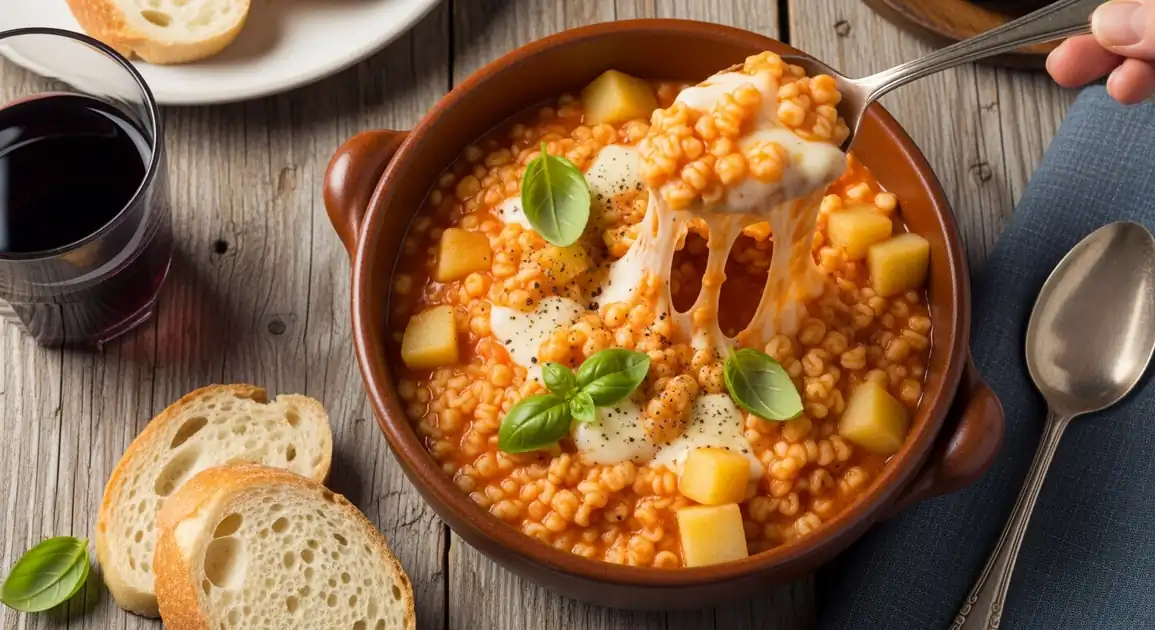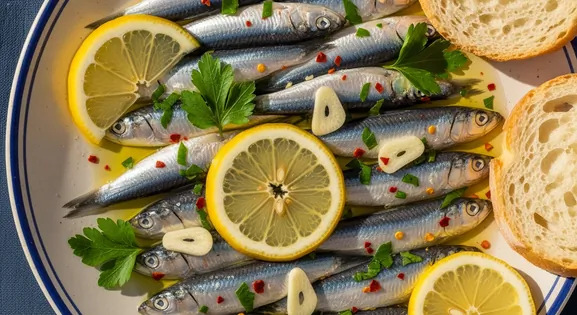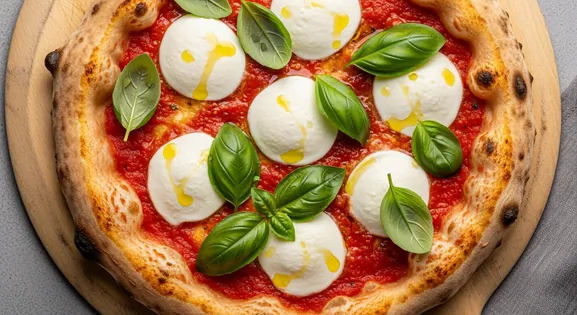Pasta e Patate con Provola in Naples
Pasta e patate cu' provola

A Guide to the Local Experience
Stepping into a Neapolitan trattoria, the aroma of slow-cooked comfort food fills the air. Pasta e Patate con Provola, a humble yet profoundly satisfying dish, is a true taste of Naples' culinary soul. It's more than just food; it's a warm embrace, a testament to Neapolitan ingenuity and tradition.
New to Pasta e Patate con Provola? Learn all about its history in our complete guide.
Key Tips for Enjoying This Dish
Many traditional Neapolitan trattorias feature Pasta e Patate as a special on Wednesdays, often prepared with extra care and authenticity. It's a local tradition.
Authentic versions use 'pasta mista' (mixed pasta shapes), often leftover pieces. This indicates a traditional, 'cucina povera' approach.
Don't hesitate to use crusty bread to 'fare la scarpetta' (literally 'make a little shoe') and sop up every last bit of the delicious sauce. It's expected!
Exploring Naples for the Best Pasta e Patate con Provola
Quartieri Spagnoli
This maze-like neighborhood houses many traditional family-run trattorias serving excellent versions of the dish.
Via Pignasecca, Via Toledo, Trattoria da Nennella
Lunch, Wednesday
Sanità
Authentic, working-class neighborhood known for its vibrant local life and excellent traditional eateries, offering a genuine Neapolitan experience away from typical tourist routes.
Palazzo dello Spagnolo, Basilica Santa Maria della Sanità
Lunch, Early Dinner
Centro Storico
The historic center has several well-established restaurants serving traditional versions, though often at higher prices.
Spaccanapoli, Via dei Tribunali, Piazza Dante
Lunch, Dinner
Vomero
This hillside residential district has family trattorias catering to locals rather than tourists.
Castel Sant'Elmo, Villa Floridiana
Lunch, Dinner
Vendor Tips
- Ask if they use 'pasta mista' - this is the traditional approach and indicates authenticity.
- Look for places where Neapolitan seniors are dining - they're the harshest critics of traditional dishes.
- Some of the best places have no English menus or online presence - look for handwritten menus.
- Ask if Wednesday is their traditional pasta e patate day - many places take special pride in their Wednesday version.
An Authenticity Guide
What to Look For
-
Trattorias in neighborhoods like Quartieri Spagnoli or Montesanto displaying daily menus ('menu del giorno').
Indicates fresh preparation rather than a static tourist menu. Pasta e patate is often a daily special.
-
Visible steam rising from the dish when served.
Crucial for texture and safety; ensures it's freshly cooked or properly reheated, especially important in Naples' humid climate.
-
Use of 'pasta mista' explicitly mentioned or visible.
Hallmark of Neapolitan authenticity for this dish. Avoid places using single pasta shapes.
What to avoid
-
Restaurants with prominent picture menus near the cruise terminal or main train station.
Often cater to tourists with lower quality standards. Seek out spots favored by locals deeper in the city.
-
Dishes where the provola looks oily, separated, or congealed.
Suggests improper reheating or that the dish has been sitting too long, affecting taste and safety.
-
Watery consistency lacking the typical creamy texture.
Indicates shortcuts or incorrect preparation, common in less authentic Neapolitan eateries.
Practical Details for Enjoying Pasta e Patate con Provola
Dietary Information
Important Note for Travelers: Your safety is our priority. Below are the common allergens associated with the traditional preparation of this dish. However, recipes and ingredients can vary significantly between establishments. Always confirm all ingredients directly with the food vendor before ordering, especially if you have a severe allergy.
Potential Allergens
Dietary Suitability
Price Guide
Budget Tips
- Most affordable in small family-run trattorias in neighborhoods like Quartieri Spagnoli and Sanità (6-8 EUR).
- Tourist-oriented restaurants near attractions like Piazza del Plebiscito or Castel dell'Ovo typically charge more (10-12 EUR).
- Lunch menus often offer better value than dinner prices.
- Some trattorias offer a 'menu fisso' (fixed menu) that includes pasta e patate as a primo at a good value.
Serving & Seasonality
Served in a deep ceramic bowl or plate, hot enough that the provola creates strings when you lift your spoon. Always accompanied by local crusty bread for sopping up the last bit. Proper consistency should be thick enough that a wooden spoon would almost stand up in it.Best Times to Enjoy
- Lunch: The traditional time to enjoy this dish, especially midweek when many Neapolitans specifically seek it out.
- Dinner: Available throughout dinner service, though some locals consider it more appropriate for lunch.
- Wednesday: Traditionally the designated day for pasta e patate in Naples, when many trattorias feature it as a special.
Seasonal Availability
Available year-round in Naples, but particularly cherished during autumn and winter months. Some traditional places only serve it from September through April.
A Simple Guide to Ordering
When ordering, specify 'con provola' to ensure you get the smoked cheese version, which is the most popular. It's typically served as a 'primo piatto' (first course), so consider ordering it before a main. Don't be afraid to ask for a recommendation from the waiter; they often take pride in their daily specials. If you see it on a 'menu del giorno' (daily menu), it's likely a fresh, well-prepared option.
A Look at Local Preparations
Pasta e Patate con Provola e Pancetta
The addition of pancetta or guanciale (pork cheek) adds a savory depth that many Neapolitans consider essential to the traditional flavor profile.
Pasta e Patate alla Genovese
A fusion variation incorporating Naples' famous slow-cooked onion-based Genovese sauce into the pasta e patate for added richness.
Pasta e Patate con Cotiche
The traditional addition of pork rind that simmers in the dish to add flavor and is typically removed before serving - though some traditional places leave pieces in.
Pasta e Patate Bianca
A 'white' version prepared without tomato, focusing purely on the potatoes and provola. Less common but considered by some purists to be the original version.
Traditions and Etiquette
Local Significance
For Neapolitans, pasta e patate represents their cultural ingenuity and resilience - the ability to create extraordinary flavor from ordinary ingredients. It's considered a quintessential comfort food that embodies the spirit of 'cucina povera' (poor cooking) that defines much of Naples' culinary heritage.
Eating Customs
- In Naples, it's perfectly acceptable to request extra provola if you enjoy the cheese aspect.
- Using bread to clean the bowl ('fare la scarpetta') is not just allowed but expected with this dish.
- Traditionally eaten with a wooden spoon, though metal spoons are now common in restaurants.
Getting the Most Out of Your Meal
Finding Authentic Pasta e Patate in Naples
Find authentic Pasta e Patate con Provola in Naples. Taste this creamy pasta and potato dish.
- Explore the side streets of the Centro Storico (Via dei Tribunali, Spaccanapoli) or areas like Quartieri Spagnoli.
- Look for small, unassuming 'trattoria' or 'osteria' signs, often family-run.
- Listen for Italian conversations – a busy place filled with locals is a prime indicator.
- Check the menu (often handwritten or on a blackboard) for 'Pasta e Patate con Provola'.
- Order it as a 'primo piatto' (first course) as is traditional in Naples.
Our Commitment to Quality
At Tasteplorers, our mission is to provide the most accurate and useful travel information in the world. To achieve this, all content on this site is created through our unique editorial framework. We utilize leading AI research tools, guided by our proprietary prompts, and a multi-stage validation process. This entire system is overseen by our editorial team to ensure everything we publish meets our high standards for accuracy, cultural nuance, and practical value for travelers.
Learn more about our Editorial Process and our Mission.
Countries
Explore regions
Europe
Discover Europe's diverse culinary landscape, from Mediterranean flavors to hearty Alpine fare. Learn to navigate markets, decode menus, and eat like a local.
Latin America & Caribbean
Discover the vibrant cuisines of Latin America & the Caribbean. Our expert guide covers everything from Mexican street food to Peruvian ceviche and market tips.
Oceania
Explore Oceania's diverse food scene. Learn about Polynesian earth ovens, Fijian feasts, and the vibrant café culture of Australia and New Zealand.
Southeast Asia
Explore Southeast Asia's diverse food cultures from Thailand to Vietnam. Get expert tips on navigating spice levels, choosing quality vendors, and understanding the rich traditions of the region.


